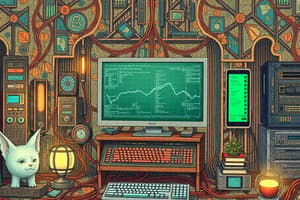Podcast
Questions and Answers
What does Information Technology (IT) primarily involve?
What does Information Technology (IT) primarily involve?
- Physical computing equipment only
- Manual data processing techniques
- The use of digital systems to manage data (correct)
- Software development only
Which of the following is NOT a component of Information Technology?
Which of the following is NOT a component of Information Technology?
- Human resources (correct)
- Software
- Hardware
- Networks
What is Cloud Computing primarily associated with?
What is Cloud Computing primarily associated with?
- Offline data storage solutions
- On-demand computing resources over the internet (correct)
- Local server management
- Physical data centers only
Which trend in Information Technology focuses on protecting systems and data from attacks?
Which trend in Information Technology focuses on protecting systems and data from attacks?
Which technology involves machines performing tasks that require human intelligence?
Which technology involves machines performing tasks that require human intelligence?
What does Data Management involve?
What does Data Management involve?
Which of the following poses a challenge in Information Technology?
Which of the following poses a challenge in Information Technology?
What is the Internet of Things (IoT) primarily concerned with?
What is the Internet of Things (IoT) primarily concerned with?
Study Notes
Definition
- Information Technology (IT) refers to the use of computers, software, networks, and other digital systems to store, process, and transmit data.
Key Components
-
Hardware
- Physical devices like computers, servers, networks, and peripherals.
-
Software
- Programs and applications that run on hardware.
- Divided into system software (e.g., operating systems) and application software (e.g., word processors).
-
Networks
- Systems that connect computers and devices to share resources and communicate.
- Includes LAN (Local Area Network), WAN (Wide Area Network), and the Internet.
-
Data Management
- Techniques and technologies for storing, retrieving, and manipulating data.
- Includes databases and data warehouses.
Importance
- Supports business operations and decision-making.
- Enhances communication and collaboration.
- Drives innovation and efficiency.
Trends in Information Technology
-
Cloud Computing
- On-demand availability of computing resources over the internet.
- Examples: AWS, Microsoft Azure, Google Cloud.
-
Artificial Intelligence (AI)
- Machines and software that can perform tasks that typically require human intelligence, such as learning and decision-making.
-
Cybersecurity
- Protecting systems, networks, and data from digital attacks.
- Involves risk management, threat detection, and incident response.
-
Big Data
- Analyzing large sets of data to uncover patterns, trends, and insights.
-
Internet of Things (IoT)
- Network of physical objects connected to the internet, collecting and exchanging data.
Challenges
- Data security and privacy concerns.
- Rapid technology changes requiring constant adaptation.
- Integration of new technologies with legacy systems.
- Skills gap in the workforce.
Career Opportunities in IT
- Software Developer
- Network Administrator
- Data Analyst
- Cybersecurity Specialist
- IT Project Manager
Certification and Education
- Common certifications: CompTIA A+, Cisco CCNA, Microsoft Certified: Azure Fundamentals.
- Educational pathways: degrees in Computer Science, Information Systems, or related fields.
Definition
- Information Technology (IT) encompasses the utilization of computers, software, networks, and digital systems for data storage, processing, and transmission.
Key Components
- Hardware
- Includes physical devices such as computers, servers, networks, and peripherals essential for IT operations.
- Software
- Comprises programs and applications operating on hardware; classified into system software (like operating systems) and application software (such as word processors).
- Networks
- Connectivity systems allowing resource sharing and communication among computers and devices; types include Local Area Networks (LAN), Wide Area Networks (WAN), and the Internet.
- Data Management
- Involves techniques for storing, retrieving, and manipulating data, encompassing databases and data warehouses.
Importance
- IT supports business operations and aids in decision-making processes, enhancing communication and collaboration while driving innovation and efficiency.
Trends in Information Technology
- Cloud Computing
- Provides on-demand access to computing resources via the internet, with key players including AWS, Microsoft Azure, and Google Cloud.
- Artificial Intelligence (AI)
- Encompasses machines and software performing tasks that typically necessitate human intelligence, like learning and decision-making.
- Cybersecurity
- Focuses on safeguarding systems, networks, and data from digital threats, involving practices like risk management, threat detection, and incident response.
- Big Data
- Involves analyzing vast data sets to identify patterns, trends, and insights that inform business strategies.
- Internet of Things (IoT)
- Refers to a network of interconnected physical devices that collect and exchange data over the internet.
Challenges
- Ongoing concerns around data security and privacy.
- Rapid technological advancements necessitate continual adaptation.
- Integrating new technologies with existing legacy systems poses a significant challenge.
- A skills gap in the workforce highlights the need for ongoing training and education.
Career Opportunities in IT
- Roles include Software Developer, Network Administrator, Data Analyst, Cybersecurity Specialist, and IT Project Manager.
Certification and Education
- Common IT certifications include CompTIA A+, Cisco CCNA, and Microsoft Certified: Azure Fundamentals.
- Educational paths often involve degrees in Computer Science, Information Systems, or related disciplines.
Studying That Suits You
Use AI to generate personalized quizzes and flashcards to suit your learning preferences.
Description
This quiz covers the key components of Information Technology including hardware, software, networks, and data management. It also discusses the importance of IT in business operations and current trends such as cloud computing. Test your knowledge on how IT supports innovation and efficiency.




